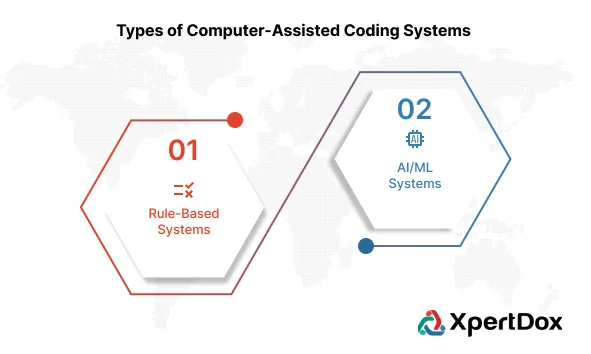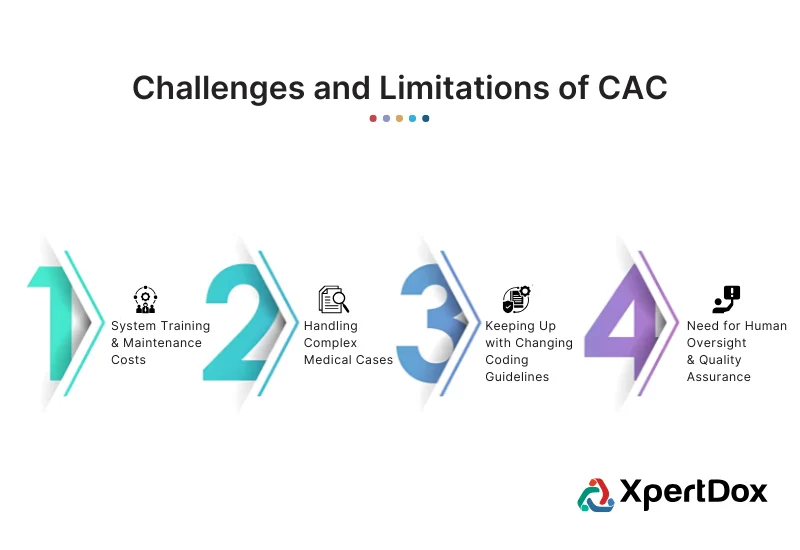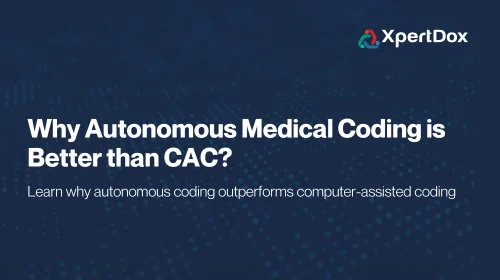Computer-assisted coding (CAC) has played an important role in medical coding by assisting coders with code suggestions based on clinical documentation. Traditional CAC relies on rule-based algorithms, while AI-ML-based CAC incorporates artificial intelligence to improve accuracy. However, both forms of CAC fall short of addressing the demands of modern healthcare organizations and RCM teams.
Computer-assisted Coding (CAC) vs. Autonomous Medical Coding
Traditional CAC requires human validation for every code suggestion and depends on static algorithms that need frequent manual updates to stay compliant. This reliance on manual intervention slows down workflows, increases errors, and makes scaling operations costly and inefficient.
AI-ML-Based CAC introduces smarter code suggestions but still requires human oversight for validation and fails to automate denial management. While more advanced, it only partially addresses critical challenges, leaving gaps in efficiency, scalability, and revenue optimization.
Autonomous Medical Coding eliminates these limitations by fully automating the end-to-end coding process. Powered by advanced AI, NLP, and machine learning, autonomous systems handle everything from documentation analysis to claim submission and denial management—without human intervention.
In this blog, you will explore in detail what is CAC, the key differences between traditional CAC, AI-ML-based CAC, and autonomous medical coding. You’ll also learn how autonomous coding overcomes the challenges of CAC, delivers operational and financial efficiency, and transforms healthcare workflows for the better.
What is Computer-Assisted Coding(CAC)?
CAC stands for computer-aided coding in medical coding. It denotes a system that utilizes software to automatically assign medical codes based on clinical documentation, enhancing coding precision and productivity.
The system suggests the correct codes by analyzing data inputs, helping coders apply the correct codes more efficiently. Thus, the system improves the quality of medical records and billing accuracy.
Computer-assisted coding (CAC) harnesses rule-based processes, Natural Language Processing (NLP), and Machine Learning (ML) to streamline medical coding. CAC translates patient data into standardized codes (ICD, CPT, HCPCS), significantly minimizing human error, improving coding accuracy, and accelerating the claims processing workflow. Notably, CAC has been shown to reduce coding time by 22%, a major asset during the transition to ICD-10 standards and in managing high data volumes. By automating routine tasks, CAC allows medical coders to concentrate on complex cases, optimizing workflow and enhancing overall coding accuracy. This synergy of automation and human expertise ensures compliance and enables healthcare professionals to focus more on patient care rather than administrative processes.
Historical Evolution of CAC
The journey of CAC began in the late 20th century with the advent of basic coding software. Initially, these systems were rule-based and required significant human intervention.
Despite advancements such as the integration of Natural Language Processing (NLP), these systems remain reliant on human oversight, particularly in ambiguous or multifaceted coding scenarios.
How Computer-Assisted Coding Works?
Understanding how CAC operates is crucial to appreciating its impact on medical coding. Its core components include Natural Language Processing (NLP) and machine learning.
You need to understand each of these components to understand how CAC works.
Natural Language Processing (NLP) and its Role
NLP is vital to CAC systems, as it allows the software to interpret and analyze unstructured clinical text, like physician notes, translating it into structured data. Through an understanding of context and medical terminology, NLP generates accurate medical codes.
Machine Learning Integration
Machine learning enhances CAC by allowing the system to learn from previous coding decisions and improve over time. The system refines its coding suggestions through continuous learning, becoming more accurate and reliable.
The Workflow of CAC
Now that you understand the core components, let's explore CAC's workflow. As mentioned below, the typical workflow involves several steps.
- First, clinical documentation is input into the system.
- The CAC software then processes this information using NLP and machine learning algorithms to generate suggested codes.
- Finally, human coders review these suggestions, making necessary adjustments to ensure accuracy and compliance with coding guidelines.

Types of Computer-Assisted Coding Systems
Did you know that an AHIMA study found that coders who used a CACS spent 22% less time coding a record than coders who didn't consult a CACS?
Computer-Assisted Coding (CAC) systems are transformative tools designed to streamline the medical coding process by leveraging advanced technology. These systems help healthcare providers improve coding accuracy and efficiency, reducing manual effort and minimizing errors.
These systems can be categorized into the following two types:
- Rule-based systems
- AI/machine learning systems
Explore the two systems thoroughly below.
Rule-Based Systems
Rule-based CAC systems operate on predefined coding rules and guidelines, typically represented in an "if-then" format.
These systems generate codes by applying specific rules to the input data. While effective for straightforward cases, they may struggle with complex or ambiguous clinical information.
Some examples of the rules include the following:
- Rule 1: If A and C, then Y.
- Rule 2: If A and X, then Z.
- Rule 3: If B, then X.
- Rule 4: If Z, then D.
AI and Machine Learning Systems
AI and machine learning CAC systems use advanced algorithms to analyze and interpret clinical documentation. These systems learn from past coding decisions, improving their accuracy and adaptability.

Now that you know about the types, you might wonder how these two are so different and what their differentiating features are. If so, the next section has you covered.
Differences Between Rule-Based and AI/ML Systems
The primary difference between rule-based and AI/ML systems lies in their approach to coding.
Rule-based systems rely on static rules. On the other hand, AI/ML systems adapt and evolve based on new data and coding practices. This adaptability makes AI/ML systems more suitable for handling complex and varied clinical information.

Top 5 Challenges and Limitations of CAC and AI-ML-based CAC Medical Coding
Despite its advantages, CAC technology faces several challenges and limitations. These challenges include the initial investment and ongoing maintenance costs, as well as the need for continual updates and human oversight to ensure the system remains effective and accurate.
While CAC helped bridge the gap between manual and automated coding, it remains rooted in an era of partial automation. Its dependency on human oversight and inability to autonomously handle routine or complex cases means its potential is inherently limited.

Challenges of CAC – Even with AI-ML Integration
Dependence on Human Coders
Traditional CAC systems, including those integrated with AI-ML technologies, depend on human coders to review, validate, and finalize system-generated codes. This reliance not only slows the coding process but also introduces the potential for human error. While AI-ML systems have the capacity to suggest improved codes over time, the absence of full automation leaves coders with the burden of validation.
Limited Denial Management
Although AI-ML-based CAC systems can identify patterns in denied claims, they lack the capability to autonomously resolve and resubmit these claims. This limitation creates a significant gap in revenue recovery, as studies indicate that 65% of denied claims are never revisited, resulting in substantial lost revenue opportunities.
Static vs. Adaptive Learning
AI-ML CAC systems utilize algorithms that learn from historical data; however, they frequently depend on rule-based frameworks requiring regular updates to maintain compliance with evolving standards, such as ICD-10, CPT, and HCPCS. The adaptability of AI-ML in CAC remains restricted when compared to fully autonomous systems, which can dynamically adjust and self-improve without extensive manual intervention.
Scalability Challenges
CAC systems inherently face scalability challenges. During periods of high patient volume, the reliance on human coders for validation constrains their capacity to handle fluctuating workloads. This limitation presents a bottleneck for healthcare organizations, particularly during staffing shortages or unexpected surges in demand.
Incomplete Automation
Despite the integration of AI-ML, CAC solutions only partially automate the coding process. These systems primarily focus on code suggestion rather than end-to-end automation, leaving gaps in efficiency and creating opportunities for delays and errors.
Now with Autonomous Coding, the next generation of medical coding solutions builds upon CAC's foundation and surpasses it in every way.
Autonomous medical coding software solutions, like XpertCoding by XpertDox, surpass CAC and AI-ML-based CAC in effectiveness. It eliminates the need for human intervention, adapts dynamically to evolving coding standards, and fully automates the medical coding process. By bridging the gaps in scalability, denial management, and adaptability, autonomous coding represents the future of medical coding technology.
- From Productivity to Autonomy: While CAC improved productivity by assisting coders, Autonomous Coding eliminates manual intervention in routine tasks, freeing up human coders for strategic oversight.
- From Error Reduction to Error Elimination: CAC reduces errors, but Autonomous Coding goes further by leveraging advanced AI to assign codes independently, drastically reducing errors across the board.
- From Consistency to Adaptability: CAC ensures consistency by adhering to guidelines, but Autonomous Coding continuously adapts to evolving standards and practices, keeping pace with regulatory changes without the need for manual updates.
- From Faster Claims to Instantaneous Processing: Where CAC speeds up claims processing, Autonomous Coding accelerates it further, often processing routine cases in under 24 hours with unparalleled accuracy.
Worried about inefficiencies in your medical coding process? Schedule a personalized demo to witness how our AI-driven autonomous coding solution can streamline your medical coding and claims processing.
Top 5 Benefits of Autonomous Medical Coding Over Computer-Assisted Coding (CAC)
While Computer-Assisted Medical Coding (CAC) has been a stepping stone in revolutionizing medical coding processes, Autonomous Coding takes this foundation and pushes the boundaries further. By minimizing manual intervention and surpassing CAC in both efficiency and accuracy, Autonomous Coding provides unmatched benefits to healthcare providers.
What Healthcare and RCM Organizations Can Expect:
1.
Unmatched Automation and Accuracy:
- Fully Automated Medical Coding: Automates 94% of claims without human intervention, ensuring speed, accuracy, and efficiency with minimal supervision.
- Performance-Based Coding: Tracks quality and performance metrics effectively, including support for Category II CPT codes.
- Reduced Coding Errors: Minimizes errors to less than 1%, ensuring compliance and reducing claim denials.
- Error-Free Submissions: Removes erroneous ICD and CPT codes during the coding process, leading to precise claim submissions and optimal financial outcomes.
- Faster Claim Processing: Submits claims in less than 24 hours, accelerating reimbursements and reducing backlogs.
- Smart Claim Scrubber: Customizable to align with payor-specific rules, reducing rejections and improving claim submission success.
- EHR-Agnostic Solution: Ensures seamless workflows by enabling data extraction and claim submission with any EMR/EHR system.
- Claim Optimization: Modifies and improves 80% of claims, streamlining workflows and enhancing operational efficiency.
2.
Enhanced Financial Outcomes:
- Flexible Pricing Model: Transparent, per-claim pricing for scalable and cost-effective solutions tailored to individual needs.
- Increased Charge Capture: Delivers a 15% improvement in charge capture, optimizing revenue generation.
- Reduced Denials: Lowers claim denials by 22%, strengthening the revenue cycle and minimizing payment delays.
3.
Revenue Cycle Optimization and Advanced Insights:
- Revenue Cycle Dashboard: Provides real-time visibility into performance metrics and financial health for data-driven decisions.
- Clinical Documentation Improvement (CDI): Enhances compliance and documentation accuracy, improving financial outcomes and streamlining workflows.
- Advanced Analytics Suite: Benchmarks provider and clinic performance with actionable insights for strategic decision-making.
- Missed Charge Recovery: Proactively identifies and retrieves overlooked charges from previously submitted claims, ensuring revenue integrity.
4.
Secure and Risk-Free Implementation:
- HIPAA-Compliant Infrastructure: Ensures secure data privacy and regulatory compliance for healthcare organizations.
- Risk-Free Implementation: Offers zero upfront fees and a complimentary first month, enabling organizations to experience benefits without risk.
- Global Certifications: Complies with ISO 27001, ISO 22301, and SOC2 Type II standards for data security and reliability.
5.
Unmatched Automation and Accuracy:
- Reduces charge entry lag by 40%, ensuring timely claim submissions.
- Achieves less than 1% coding errors, significantly improving compliance and reducing denials.
- Enhances efficiency, allowing healthcare teams to focus more on delivering high-quality patient care.
Transform Your Coding Process with XpertCoding
Take your medical coding efficiency to the next level with XpertCoding’s AI-powered Autonomous Coding solutions. Achieve unparalleled accuracy, reduce costs, and accelerate claims processing—all while seamlessly connects with your EHR systems. Let XpertDox’s Autonomous Coding redefine your workflows and drive healthcare excellence.
What to Look for in Medical Coding Software?
Did you know that the average rate of claim denials can hit 23 percent, with a large portion of them rooted in missing or invalid data? Choosing the right medical coding software will help you minimize errors.
When choosing medical coding software, several key factors must be considered to ensure you select a solution that effectively meets your needs. The most crucial ones are listed below.
- Compliance and Accuracy: Ensure the software meets the latest coding standards and guidelines, including ICD-10, CPT, and HCPCS. The vendor should provide regular updates to reflect changes in coding rules and regulations.
- Connection Capabilities: Check if the software connects seamlessly with your existing Electronic Health Records (EHR) and practice management systems. Integration can enhance workflow efficiency and data accuracy.
- User-Friendliness: Look for an intuitive and user-friendly interface that minimizes the learning curve for coders. The software should provide easy navigation and clear instructions to support efficient coding.
- Customization Options: Evaluate whether the software can be tailored to your specific needs, such as custom coding rules or templates. Flexibility in customization helps accommodate unique coding requirements.
- Support and Training: Consider the level of customer support and training the vendor provides. Robust support can help resolve issues quickly, and comprehensive training ensures your team can use the software effectively.
- Data Security: Ensure the vendor prioritizes data security and complies with relevant privacy regulations, such as HIPAA. The software should have robust security measures to protect sensitive patient information.
- Reporting and Analytics: Look for features that offer detailed reporting and analytics capabilities. These tools can provide insights into coding accuracy, productivity, and areas for improvement.
- Scalability: Assess whether the software can scale with your organization’s growth. It should be able to handle increased volumes of coding without compromising performance.
When evaluating medical coding software, it's crucial to differentiate between CAC and Autonomous Coding. CAC aids human coders by suggesting codes but still requires manual review. Autonomous Coding, like XpertDox’s AI-powered autonomous medical coding system, assigns codes automatically without human intervention. While CAC boosts productivity, autonomous coding minimizes errors, speeds up claims, and streamlines processes, making it ideal for high-volume environments. Choosing the right system enhances coding efficiency and aligns with your organization's goals.
Worried which medical coding software will be compatible with your EHR system? XpertCoding by XpertDox is the answer to all your questions.
Conclusion
As healthcare organizations strive to improve efficiency, accuracy, and financial outcomes, the limitations of traditional and AI-ML-based CAC systems become increasingly apparent. While CAC has been a valuable step in advancing medical coding, it still falls short in addressing critical challenges such as scalability, denial management, and end-to-end automation.
Autonomous medical coding offers a transformative solution, fully automating the coding process while ensuring unmatched accuracy, speed, and adaptability. By eliminating the need for manual intervention, autonomous systems not only enhance operational efficiency but also enable organizations to recover revenue, scale seamlessly, and stay compliant with evolving standards.
In this blog, you’ve seen how autonomous medical coding overcomes the inefficiencies of CAC and why it’s the future of healthcare operations. As you consider the next steps for your practice or organization, explore how adopting an autonomous solution can revolutionize your workflows, optimize your revenue cycle, and position you for long-term success in a rapidly evolving industry.
Ready to revolutionize your medical coding process? Discover how XpertDox can improve it and provide ROI.
Published on - 01/28/2025
Want to learn more about XpertDox?
Frequently Asked Questions
-What is the difference between Computer-Assisted Coding (CAC) and Autonomous Coding?
CAC is a tool that helps human coders by suggesting codes based on the documentation, but it still requires manual review and final code selection by a coder. Autonomous Medical Coding, on the other hand, involves fully automated systems that assign codes without human intervention, handle routine tasks independently, and require human oversight only for complex cases.
-How does Autonomous Coding reduce errors compared to CAC?
Autonomous Coding relies on advanced artificial intelligence (AI) and machine learning algorithms that continuously learn and improve from large datasets. These systems are less prone to the human errors often encountered in manual coding or CAC-assisted processes. Autonomous systems also work faster and can identify complex patterns that might be missed by human coders, thus reducing errors in routine coding tasks.
